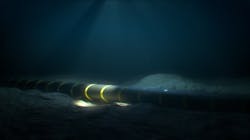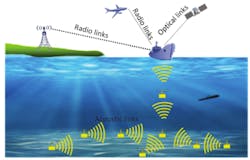Q: I would like to know what are the methods of finding the locations of damage on undersea power cables—transporting large quantities of green electricity (500-1,000 MW) over long distances (over 1,000 km)—or damages on similar capacity hydrogen (liquid or gas) pipelines? To your knowledge, are such under-ocean transportation systems in operation? Do they transport green energy? Are their costs published?
I read that such systems are being built in Europe but would like to learn more. If you or your expert colleagues could point me to some cost or operating reports, I would be grateful.
Z. Friedmann
A1: This is the type of question I like, not only because it relates to an evolving new technology, but also because it takes the understanding of the capabilities of measurement and control to meet this challenge.
Your question is logical: the conversion to a green energy economy will require long distance energy transportation. That’s because much of the green energy will probably be collected in unpopulated areas—where there is plenty of insolation and/or wind—and will have to be transported to the users from such offshore wind farms or distant solar plants, either by undersea (submarine) power cables or in hydrogen pipelines.
The yearly total electricity consumption of mankind is about 150 Q (Q=1015 BTU). In high energy concentration areas on land or in the ocean, the solar or wind energy concentration is about 200 GWh/yr/mi2. Therefore, meeting our global electricity needs would require an area of about 225,000 sq. mi. (roughly the area of a square with sides of 500 miles). This is an immense area. If the farms were on land, they would take up 7% of the area of the Sahara. Naturally, less area will be needed because much green energy will be collected elsewhere. Still, some undersea long-distance transportation will be required.
Up to a distance of about 80 km, these power cables usually carry AC power. For longer distances, high-voltage DC current is used. One example of such an installation is the 450-km and 1.6 billion euro North Sea Link (NSL) that is connecting the U.K. with Norway and will eventually have a total capacity of 1,400 MW (larger than a nuclear reactor). It is a link between Norway’s hydropower and the U.K.’s wind energy resources. When Britain’s wind production is high and demand for electricity is low, the cable exports energy to Norway where it is stored in hydropower facilities. When demand in Britain is high and the wind generation is low, hydropower is imported back from Norway. Even longer "green" cables are planned between the U.K. and Iceland (1,200 km) and between the solar farms in Azerbaijan and Hungary, where the 1,100-km cable passes on the bottom of the Black Sea.
Today, time domain reflectometers (TDR) are most often used to roughly identify the fault location (their accuracy is about 1% of cable length). In case of the 1,000-km cable, this is ±10 km, and this precision in insufficient. One method of improving this accuracy is to place reference points at known locations in the cable, but that too is imprecise.
Submarine hydrogen pipelines: Nearly 2,000 miles of "gray" hydrogen pipelines have been in safe operation in the U.S. for decades. Some of the natural gas supplies are blended with up to 15% H2 to reduce its CO2 and NOx emissions, which exacerbates or causes asthma, acid rain and ozone depletion. This blending is a temporary step. In the long term, the electric grid itself will move underground and an H2 distribution piping network will expand into a parallel grid so that fueling stations can serve both battery and fuel cell-powered cars, and regular homes can both be connected to either or both.
Long submarine hydrogen pipeline systems do not exist, they are only beginning to be built. These systems have four components, the electrolyzer/compressor that converts green energy into pressurized hydrogen gas, the pipeline itself, the facility to store excess H2 generated during periods of low electric demand and the fuel cells (if needed) to convert the H2 back into electric power. One of the first such systems, a “green” 455-km long submarine pipeline is under construction between Barcelona and Marseille, which, at times of green hydrogen shortage, will also transport "red" H2 from France back to Spain. The pipe is sized for a capacity of 2 million tons of H2 per year. It is expected to cost $2.6 billion and is planned to be expanded to become a 10 million ton/year EU hub by the end of the decade.
According to one estimate, the cost of a 36-inch submarine pipeline, yearly transporting 10 GW of green H2 over a distance of 1,000 miles, is estimated to be 12% less than transmitting that same energy by a high-voltage submarine power cable. The study estimates that such transmission of H2 by submarine pipes costs $1,226 MWa/mi. The same transmission by electric cable would cost $1,400 MWa/mi.
All energy transmission involve loses, which are a function of length, capacity, etc. Over a 1,000-km transmission length, they amount to about 5% of the power carried. In case of H2 transmission, most losses are caused by leaks and embrittlement. H2 system costs are expected to be reduced by lowering pipe weight plus lowering the cost of electrolyzers and reliability of compression technology. One very promising effort involves the use of fiber reinforced polymer (FRP) pipelines for hydrogen distribution. These pipes are less expensive and are available in sections that are much longer than steel, minimizing requirements for welding.
Bela Liptak
[email protected]
A2: Not a bad idea for Europe where the undersea distances are short, but not really appropriate for transatlantic or transpacific power or hydrogen/ammonia pipelines.
The Internet and long-distance telephony are currently enabled by many undersea fiber-optic communications cables across most of the oceans and seas of the world, but these work by transmission of light at many frequencies. Undersea fiber-optic cables carry DC electricity to power the Erbium-doped fiber amplifiers (EDFA) placed approximately every 75 km along the cable. These cables require maintenance occasionally as they are damaged by ship anchors, but if they are damaged, nothing is released to the surface. Laying of undersea fiber-optic communications cable is a fine art using prefabricated coils of cable and specialty cable laying ships.
There are also long-distance electrical transmission cables used in Europe to carry power across the shorter distances under those European seas. These are DC transmission lines with very high voltage to minimize IR heating loss.
Applying long-distance pipeline surface technology to undersea pipelines seems possible, but if such a pipeline is damaged by ship anchors as experienced by fiber-optic communications cables, the fluid in the pipeline would be released potentially damaging to the atmosphere and polluting the ocean. Surface pipeline repair is costly and time consuming, but undersea pipeline repair would be much more costly.
Finally, there is currently no technology developed to lay pipes on the sea bottoms for any distance. Obviously, crude oil is carried by short undersea pipelines from offshore production platforms, but these are short distances compared with transatlantic and transpacific distances.
Richard H. Caro
Control Consultant
[email protected]
About the Author
Béla Lipták
Columnist and Control Consultant
Béla Lipták is an automation and safety consultant and editor of the Instrument and Automation Engineers’ Handbook (IAEH).

Leaders relevant to this article:




